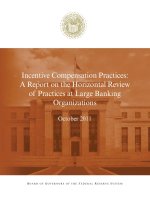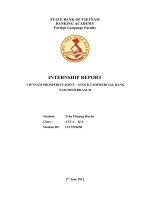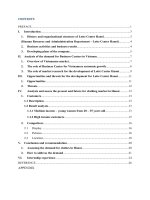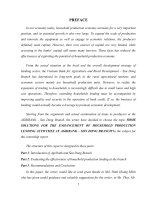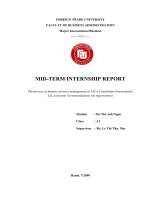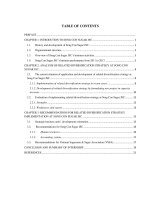Internship report - Import-export practices at europlast jsc
Bạn đang xem bản rút gọn của tài liệu. Xem và tải ngay bản đầy đủ của tài liệu tại đây (270.3 KB, 23 trang )
1.4.2. Filler Master Batches 7
1.4.4. Color Master Batch tch 8
1
INTRODUCTION
Since the issuance of new policies on diplomacy and economy of Vietnamese
government in 1986, namely Doi Moi era, Vietnam has set up its business relationship
with most countries in the world, even with former millitary opponents such as the
United States or Japan. Every year, exportation contributes billions of dollars to the
GDP of Vietnam. In general, our main exports consist of most agricultural products
such as rice, coffee, pepper, etc. and raw natural resources such as crude oil and ores,
as well as shoes, clothing and handicraft products, all of which are very low value-
added. Meanwhile, we import manufactured goods and luxuries like car, branded
clothing, alcohol, which has made Vietnam suffer a trade deficit for a long time. In
order to improve the balance of trade, the government has encourage Vietnamese
enterprises to shift from processing goods to order of foreign companies to producing
high value-added products for exportation.
According to the schedule of Foreign Trade University, I spent a five-week
internship at Europlast Joint Stock Company, which majors in importing raw material
and manufacturing polymer and plastic products for domestic consumption as well as
exportation. Under the training of my direct instructor, Ms Pham Thi Ngoc Mai, as
well as the condescention of the company’s staff, I have been given a great opportunity
to apply my academic knowledge to practical problems and compare with the theories I
have learned at the university. Based on my background knowledge and the experience
I gained during my intership, I decide to choose the topic for this report as: “Import-
export practices at Europlast Jsc”.
The report consits of three separate parts:
Chapter 1: General information about business practices of Europlast Jsc.,
Chapter 2: Import – export practices at Europlast Jsc.,
Chapter 3: Suggestions offered to enhance the efficiency of Europlast Jsc., in
international trade
2
Due to my limitation of knowledge, skills and experience, mistakes and faults are
inevitable. I welcome all comments, advices and suggestions that help me improve the
quality of the report.
Finally, I would like to express my gratitude to my instructors and Europlast staff
for helping me complete my mid-course internship.
Ha Noi, July 18
th
, 2013
Lương Kim Anh
3
1. General information and history of development of EuroPlast
Company: EuroPlast Jsc.
Type: Joint stock company
Years active: 2007- present
Trading Office: N11, Block 1A.1.2 - N02, My Dinh 1 Urban
Area, Tu Liem District, Hanoi, Vietnam
Industry: Plastic & Polymer
Products: Master batch and additives
Website:
1.1. General information of Europlast
Founded in 2007 in Hanoi, EuroPlast Joint Stock Company is an expertise in
polymer industry and mineral resources (Talc production). Its primary products are
Filler Master Batch, Color Master Batch and Additive Master Batch. As one of the
main producers in Vietnam polymer market, Europlast has expanded equally its
activity to exportation. The company exports over 60% of its turnovers to more than 20
countries in the world.
4
Its strategic goal is to develop tailor-made solutions and technically advanced
master batches and compounds for the polymer industry by using an exclusive advance
plastic solution. We offer a comprehensive sampling service with excellent laboratory
and technical service back-up.
Focus in modern technology, high quality product and in respect of the best
service for customers, Europlast will continue to provide innovative solutions, enable
responding to every demand of global market.
1.2. Developing history of EuroplastHistry
The relative young history of EuroPlast is a story of success. The long-term
experience of its expertise in polymer's production have been, together with multiple
international relations, the relevant starting capical.
09/2007
o Foundation of the company EuroPlast, situated in Ha Nam, Vietnam.
2008
o Establishment of the first factory in Ha Nam Industry Zone: 2 lines of
production for the capacity 700 MT/month. The company employed 31 people.
o The head office was situated in Ha Nam Province.
2009
o Establishment of the representative office in Ho Chi Minh city.
2010
o Expansion of the factory with 4 new production lines. The capacity total 2500
MT/ month.
o First international presentation of EuroPlast's product to China and EU Marrket.
2011
o Establishment of new branch in Ho CHi Minh city, in the south of Vietnam.
o Establishment of Trading Office in the center of Hanoi.
o Establishment of new branch in Nghe An Province.
5
o Construction of the second factory in Nghe An, 3 hectare square total area.
o Year of exportation - The company export its product to more than 20 countries
in the world.
2012
o Expansion of the factory in Ha Nam, new building of 3000 m2 with modern and
quality equipment.
o Total capacity of EuroPlast reaches 6000 MT/month for 14 production lines.
o Purchase Talc mine in Tafu, north part of Vietnam: 99 hectare square total area.
o Purchase Talc mine in Phu Tho: 44 hectare square total area.
o The company has actually 260 employees for 40.000 MT product sales/ year.
1.3. Managerial Structure
Chart 1: Managerial structure of Europlast
(Source: Europlast human resource department)
1.4. Strategic products
Board of
directors
General
Director
Board of
controllers
Production R&D Trading Marketing Financial Administrative
Factory in
Ha Nam
- Factory in
Nghe An
- Talc mine
in Tafu
- Talc mine
in Phu Tho
-R&D
- Quality
control
- Quality
consultant
- Local
market
- Internati-
onal market
- Trading
support
- Purchasing
6
1.4.1. Filler Master Batch
Filler Master Batch is compounded of high quality filler, polymer resin and
other additive agents by twin-screw machine. It is widely used in the plastic industry
(blow film, blow molding, injection molding, wire drawing, bag molding, slip casting,
dyeing, extrusion molding) to reduce the production cost and improve the character of
final products.
EuroPlast’s Filler Master Batch is produced in a highly respective environment,
with high quality process and selective raw materials.
Application: (PE)
-Transparent film
- Injection/ extrusion
- Opaque film
- Extrusion coating film
1.4.2. Filler Master Batches
Filler Master Batches is compounded of high quality filler, polymer resin and
other additive agents by twin-screw machine. It is widely used in the plastic industry
(blow film, blow molding, injection molding, wire drawing, bag molding, slip casting,
dyeing, extrusion molding) to reduce the production cost and improve the character of
final products. Europlast's Filler Master Batch is a combination of calcium carbonate,
plastic flexibilizer and other special additives. It has good dispersion and
environmental protection, which can improve the surface antifriction, heat stability,
toughness, hardness, rigidity and increase specific gravity of plastic products.
Application: (PP)
- Woven bag
- Jumbo bag
- Injection moulding
- Extrusion
1.4.3. White Master Batch atch
7
White Master Batch is a type of polymer materials, it gives whiteness,
brightness and opacity in the final product. To provide these properties in platics, many
chemicals such as Zinc Oxide, Zinc sulphide, Antimony oxide, Titanium dioxide are
used. Titanium dioxide is mostly used in plastic application because of its unique
properties such as high refractive index, average particle size (0.19-0.22 micron).
EuroPlast’s White Master Batches are based on international quality Titanium
dioxidewith excellent optical properties such as opacifying/tinting strength, undertone,
and color. This Titanium dioxide has a unique surface treatment which gives good
dispersion in plastics and also has no effect on rheological properties of the polymer.
White Master Batch contain speciality additives which makes the resin compatible with
titanium pigment and give an ideal color for final product. Europlast has a lot of
varieties of White master batches, depending on the percentage of Titanium
dioxide (up to 70%).
Application:
- Film for complex printing
- Film for the application of packaging
- Film for the application in Se Food and Agriculture Industry
- Injection and blowing mold
1.4.4. Color Master Batch tch
Color Master Batch is a type of polymer materials dedicated colorants,
pigments, also know as preparation of materials (Pigment Preparation). It consists of
pigments or dyes, and additives vector composed of three basic elements, is the
extraordinary amont of pigment or dye evenly attached to the resin contained in the
aggregate have been, can be said to concentrate pigment (Pigment Concentration), so
shading power than his own pigments.
Main Color: black, blue, brown, green, grey, orange, red, violet, yellow
Application:
- Injection molding
8
- Blowing film
1.5. Markets
1.5.1. Domestic market
40% turnover of EuroPlast comes from local market. Its products present
in every part of the country throughout the present of representative offices and
distributor link:
- North: Head Office in Ha Nam, factory in Ha Nam, talc mine in Ta Phu, Bac Giang,
talc mine in Phu Tho, office Representative in Hanoi
- Centre: Branch in Nghe An, factory in Nghe An
- South: Branch in Ho Chi Minh City
At this moment, the company has more than 80 loyalty customers working in
packaging and plastic manufacturing industry that produce water pipes, wires,
sheath conditioning, appliances…
Europlast’s main markets include:
Hanoi Hai Duong Ha Nam Hung Yen Hai Phong
Phu Tho Bac Giang Nghe An Da Nang Quang Ngai
TP HCM Binh Duong Dong Nai Can Tho Long An
1.5.2. Exporting market
At the moment, EuroPlast have more than 40 loyal export customers in
international market including:
- Asia: China, Pakistan, India, Japan, Sri Lanka, Indonesia.
- Europe: Russian, France, Poland, Italy.
- Africa: Camaroon, Algeria, Tunisia, Egypt.
- America: Brezil, Chile, Argentina, Ecuador.
- Australia
2. Import – export practices at Europlast Jsc.
2.1. Terminology & Definition
- Purchase Order(P/O)
9
- Commercial Invoice: the request from the Seller to the Buyer asking for the
amount of money as stated in the invoice. Commercial Invoice should specify the
properties of the Good, unit price, total amount, delivery terms and condition, mode
of delivery and mode of payment.
- Packing list: the list of all the goods packed in a consignment
- Bill of lading: a certificate issued by the Carrier for the Consignor to verify that the
Good has been shipped.
- Certificate of Origin (C/O)
- Delivery order (D/O)
2.2. Importing practices at Europlast
2.2.1. Steps in importing process
Responsible
personnel
Activity Related documents
Departments Related forms
General director/
Manager
Personnel in charge
Personnel in charge BM.08.01
Related
departments
Personnel in charge BM.08.04
10
Approve
Purchasing demand
Contact, send enquiry
Find supplier
Evaluate
Stop
List of suppliers
Personnel in charge BM.08.02
General director/
Manager
Personnel in charge BM.08.02
Related
departments
Related forms
Accountant/
Personnel in charge
Prodution controller
Table 1: Importing process at Europlast
(Source: Europlast’s trading department)
Europlast has establish business relationship with both foreign and local
partners. The company purchases raw material and sells manufactured products to
customers. Raw material is bought from a variety of suppliers which provide the best
products at reasonable price regardless their geographic situation. Therefore, Europlast
has two different purchasing processes for domestic and imported goods, of which the
latter is much more complicated as it requires a number of procedures and bears more
risks and cost. In this chapter, I mainly discuss the importing process at Europlast.
The importing process generally consists of 6 steps:
Step 1: After receiving purchasing demand from some department, choosing a supplier
and getting the approval of the general director for the supplier, the purchasing
department will send an enquiry to the supplier.
11
Purchase
Make payment/ Terminate
the contract
Save files
Approve & Sign
Check/ Receive
Stop
Contract/ Order
Step 2: After some negotiation on price, quantity, quality & specification, terms and
conditions of delivery and payment etc., the two parties will make a contract. In case
of long-term suppliers, the general director will sign a ruling contract and send separate
orders with signature of head of department for each consignment. Other suppliers will
sign contract for each separate business.
Step 3: When the contract has been sign or the order has been sent, personnel in charge
will carry out the purchase and prepare all necessary documents. Europlast usually
choose FOB term imports. Therefore, it will send someone to arrange insurance and
contact the vessel office for shipment.
Step 4: When the good has been delivered, representatives of related departments and
the suppliers will check, install and test (if needed) together. If the good is up to
Europlast’s standard, they will accept it. Otherwise, they will ask the supplier to
replace it.
Step 5: Related files and documents will be transferred to Accounting Department or
the department in charge of making payment and terminating the contract.
Step 6: Related department must save files.
2.2.2. Supplier evaluation
- Evaluation for choosing potential evaluation: This type of evaluation is only
applied for new suppliers that have not been approved. When a department needs to
purchase something, it will make an application form approved by the general director
or head of department and submit to the responsible department. Then the responsible
department will send someone to collect the price quotes of at least 3 suppliers and
evaluate them using Form BM.08.01. Head of department is responsible for checking
the evaluation and submit to the General director for approval. After the general
director has approved, personnel in charge will update the information of the new
supplier in the list of approved suppliers (BM.08.01)
12
In case of demand arising at the turn of event, the personnel in charge can
directly consult the general director to appoint a specific supplier to ensure prompt
preparation of material for production.
- Tracking evaluation: Each department in Europlast will open a “ Supplier tracking
book” according to form BM.08.02. During the purchasing process, if any problem in
technical standard, quality, price, time of delivery, terms and conditions arise, it will be
recorded by the personnel in charge. The evaluation of the supplier will be based on
this tracking book. Head of related departments can remove suppliers from the
approved list depending on the evaluation standards. Head of departments will carry
out the tracking evaluation annually or when required to build a list of liable suppliers
for their departments. Revaluating standards include number of times of
nonconforming, seriousness of nonconforming, frequency of reoccurence, etc.
Form Code
Initiate supplier evaluation form BM.08.01
Supplier tracking book BM.08.02
Supplier revaluation form BM.08.03
List of suppliers BM.08.04
Purchase order BM.06.01
Table 2: List of related forms
(Source: Europlast’s trading department)
2.2.3. Steps in clearing importing procedure
Step 1: Europlast personne prepares a set of import clearance documents including:
contract, commercial Invoice, Packing List, Bill of Lading, Certificate of origin,
Importing Permission. Europlast personnel has to check the correctness and legality of
the documents before submitting them to custom. Any problem arising should be
promptly informed to the Seller to fix it at least cost and risk.
Step 2: Upon receipt of B/L or arrival notice, Europlast personnel will contact the
shipping office to get delivery order (D/O) in 4 copies.
13
Step 3: Europlast personnel submits the documents for export clearance at the customs
house. Customs will calculate the amount of tax Europast has to pay and check the
conformity of the documents and the consignment.
Step 4: Taking delivery at the port
Europlast personnel will take D/O to the port, pay all necessary fee and ask the port
staff to transport the container to the checking field
Step 5: Europlast asks a custom representative to verify that the container still have
original seal, right container number and seal number then have some worker at the
port cut the seal to open the container and check the good. After verifying that the
consignment are in accordance with submitted documents, the custom officers will
complete import clearance procedures. The consignment will be transported to
Europlast’s warehouse.
Step 6: Europlast will make payment on the base of agreed terms and conditions.
2.3. Exporting practices at Europlast
Responsible personnel Activity
Trading department
Trading department
Trading department
Trading department &
Related departments
Trading department
14
Receiving enquiry
Evaluate and
Negotiate
Stop
Making contract
Receiving order
Send offer
General director/ Manager
Production & Trading
department
Accountant/ Personnel in
charge
Prodution controller
Table 3: Exporting process at Europlast
(Source: Europlast’s trading department)
The importing process generally consists of 6 steps:
Step 1: Europlast will initiatively send an offer and a sample attached to the offer to the
customer or when receiving enquiry from a customer. The trading department will
evaluate the customer’s offer to buy and negotiate to change unreasonable terms and
conditions until the two parties have reached mutual agreement.
Step 2: The two parties officially enter a contract. The contract may cover several
orders or only one order depending on the requirement of customer. It may be by fax or
foreign partner sends their representative to sign the contract directly with Europlast.
Step 3: When the contract has been signed, Europlast will ask its customers to open an
L/C as agreed in the contract. Upon receipt of notification from the bank, Europlast
staff has to check the conformity of the L/C with agreed terms and conditions and
corrects any discrepancies as soon as possible. Production department will proceed the
order in due time under strict control while trading department arrange delivery and
insurance policy if asked by customers. Customers may send their representative or ask
a third party to check the goods. Europlast is responsible to support them during
quality checking.
15
Producing and making
delivery
Receive payment/
Terminate the contract
Save files
Approve & Sign
Step 4: The good will be packed according to the customer’s instruction, usually in
container. Europlast will hire a carrier to transport these container to the named vessel
by the customer at the port and prepare necessary documents including certificate of
origin, export allowance, etc. After, the good has been loaded on board the vessel,
Europlast staff will collect the B/L.
Step 5: Europlast will bring a full set of shipping documents to the bank and proceed
international payment. After Europlast have received money, related files and
documents will be transferred to Accounting Department and the contract will be
terminated.
Step 6: Responsible department must save files.
2.4. Evaluation on import-export practices of Europlast
Europlast’s turnover has risen dramatically throughout the year. As Europlast’s
orientation is to concentrate in exportation, they has built a long-term plan to research
and produce new polymer products that is competitive in international products. Its
main exports include filler master batch PE, filler master batch PP, white master batch
and color master batch.
Chart 2: Europlast’s exported product structure in 2012
Source: Europlast trading department
Year Domestic turnover Exporting turnover Total turnover
2008 57,657,000,000 56,996,000,000 114,653,000,000
16
2009 92,650,000,000 105,130,000,000 197,780,000,000
2010 125,067,000,000 125,896,000,000 250,963,000,000
2011 153,450,000,000 155,002,000,000 308,452,000,000
2012 130,470,000,000 189,875,000,000 320,345,000,000
Table 4: Europlast’s turnover in 2008- 2012 period
(Source: Annual report of Board of Director from 2008 to 2012)
The international commercial network of Europlastcover the world from
America to the Fareast. In 2011, about 50% of Europlast’s turnover comes from export
activities. In 2012, the proportion has expanded to nearly 60%. This number is
expected to reach 80% in 2015.
44
46
48
50
52
54
56
58
60
2008 2010 2012
Export
contribution to
total turnover
Chart 3: Proportion of exporting turnover in 2008 – 2012 period (%)
(Source: Annual report of Board of Director from 2008 to 2012)
2.4.1. Strength
As Europlast directly imports the good instead of hiring another logistic
company, they can control all the risk and cost and prevent lengthened waiting period
due to mistakes arising in the process. In addition, they establish a separate department
that specialized in import-export practices, which helps to prevent distraction from
other activity of the company and improve the efficiency of Europlast.
17
In addition, they are very careful in choosing reliable business partners and
conscious of the possibility of completing the contract in time. They are never blinded
by attracting but suspicious contract offered by untrustworthy foreign companies.
2.4.2. Weakness
However, due to lack of experience which results from the young history of
development of Europlast, it usually takes it a considerable amount of time and money
to import consignments. Eventhough Europlast has establish business with very liable
and professional partners, their own weakness in logistic practices are obstacles that
lower their effectiveness and thus, reduce profit.
2.5. Comparison with theory
The importing process of Europlast is almost the same as what I have learned at
the university. However, the theory only mentions basic steps that can be applied for
every company regardless of their characteristic features. When I observed how
Europlast personnel carries out the import clearing procedure, I realized that the
practical work is not that simple but requires extreme careful people as the risk of
losing good or fraud is high in doing business with foreign partners.
Evaluation on suppliers is a very important step in import practices that is not
mentioned in my lessons but is clearly and carefully built as an official process at
Europlast. This can be considered as a preventive method that protects Europlast from
risk of bankrupt and fraud because any mistake in the process will negatively affect
and sometimes may delay the whole producing chain because of lack of raw material.
3. Suggestion offered to improve the efficiency of Europlast in international trade
3.1. Future goals and Development orientation
In an eort to promote polymer production, Europlast has set
some
mid-term targets to 2015 in increasing both domestic and exporting
revenue. Meeting
18
these reasonable goals will be essential requirement for the
company’s sustainable long-term development.
According to this plan, at the end of 2015, Europlast will built a
new plant of 1.5 times to 2 times more than the current one in
production capability in Ha Nam, which wil increase the total
capacity of Europlast to more than 8000 MT per year. At the same
time, it will introduce a new production line of household plastic
products such as bucket, raisin and cabinet, which will be the base
for the expansion to the +eld of hygienic plastic products such as rice
bowls, soup bowls, chopsticks and food containers later. These
products use plastic of higher quality that is safe for users and free of
poisons and harmful contaminants.
To prepare for this project, Europlast will upgrade some of its
production chain to satisfy all hygenical standard. They have
forcasted that if the launch of these new products is successful,
Europlast will strive for the total revenue of around 900 to 1,000
billion of VNĐ annually in less than 5 years. As a result, both their
domestic and international market share will be increased.
However, Europlast still lack a lot of necessary resources to
complete these goals and launch the plan for the new products. It will
have to face with strong opponents which are experienced in
producing hygenical plastic products such as Lock&lock Vina, Viet
Nhat Plastic and Dai Dong Tien. Therefore, to ensure its success in
the entrance to this promising market, Europlast still has to make
preparation in many aspects including investing more capital in
facility and equipments and improving technical, managerial,
+nancial and human resouce controlling skills.
19
3.2. Suggestions
3.2.1. Improve quality of human resource
Foreign languages, professional knowledge of foreign trade and international
payment standard of Europlast’s staffs must be improved in order to catch up with
other competitors in import/export business. Companies active in this business without
enough good knowledge and experiences surely has to face with many risks, losses or
even bankrupts. Therefore, it is essential that import/export firms must improve their
skills of professional transactions as well as language skills.
When joining the field of import/export, Europlast must have import/export
specialists or skillful employees who can handle all the complicated procedures. Those
staffs have to be trained about foreign trade, international commercial law and law of
international payment. Their knowledge of Incoterms, UCP, URC, partners’ laws,
shipment and international payment terms must be updated from time to time, so that
they can achieve agreements that are more beneficial to the company when negotiating
a contract.
On top of that, they need to have high level of responsibily, honesty and
integrity. They should be aware of how important prestige and consistency are in doing
business with international partners. Because the competitiveness of Europlast does not
built on cheap labor but the quality and differentiation of its polymer products which
require intensive technical skills, human resource should always be kept under strict
control to ensure the production process runs smoothly and safely and produce best
quality products.
3.2.2. Selecting and negotiating suitable import/export contract conditions
Among many preventive methods used in international commercial, being
cautious in contract negotiating, contract signing and conditions selecting in order to
ensure the fluent of delivery is absolutely important. On the other hand, the exporters
should get their payment after delivery on agreement.
Strict regulations and conditions in contract will ensure both parties’ good
20
performances in every step of doing business while reducing flaws, avoiding risks and
saving time. However, being strict does not mean being too complicated, but to choose
suitable solutions to create safety condition for the contract executing.
Wrong choice in international commercial conditioning will affect directly to
companies’ foreign trading activities, and the first and foremost being suffered will be
payment activities, because they have influence on all the processes of the business
and contract regulations. Therefore, Europlast has to be wise, careful in negotiating
contract, to make sure the business will be transparent and quick in executing, while
there are still high chance of safety, and good conditions for payment.
CONCLUSION
Nowadays, exportation contributes more and more to annual GDP of Vietnam
and becomes a growing profit source for Vietnamese company. In the past, we only
focus on low value-added activities such as exporting agriculture products or simply
making ready-to-wear clothes to order of foreign fashion company. However, in recent
years, many Vietnamese companies have sought a new path that brings them more
profit: exporting manufactured goods instead of being a chain in the lowest part of the
value-added chain.
During the five-week internship at Europlast, I have learned both the advantages
and disadvantages the company has to face in doing business internationally and
detailed steps in the complicated process of importing and exporting. I have been
taught how to write and send professional enquiries, orders, offers and contracts in
practice by my considerous instructor, Miss Nguyen Ngoc Mai – Europlast Director
Assistant. These valueable experience will certainly help me a lot in my future career
in the field of import-export practices.
On writing this report, I have received careful instruction from Ms. Pham Thanh
21
Ha. She helped me to choose a suitable topic for the report, make a clear outline and
write the thesis with reasonable content. Thanks for reading my report!
22
REFERENCE
1. Europlast marketing department, Europlast history of development, 2012.
2. Europlast Accounting department, Europlast annual financial report, editions of
2008, 2009, 2010, 2011, 2012
3. Europlast Marketing department, Europlast polymer products, 2007
4. Europlast Trading department, Purchasing process, 2007
5. Europlast Trading department, Note on Sales and Exportation, 2007
6. James R. Pinnells, Exporting and the export contract, 1994 edition.
23
